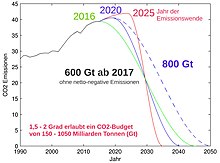2 degree climate target: Difference between revisions
Appearance
Content deleted Content added
| Line 7: | Line 7: | ||
== See also == |
== See also == |
||
* [[Anthropocene]] |
* [[Anthropocene]] |
||
* [[Climate target]] |
|||
* [[Keeling Curve]] |
* [[Keeling Curve]] |
||
* [[Eco-sufficiency]] |
* [[Eco-sufficiency]] |
||
Revision as of 20:39, 11 November 2023
The topic of this article may not meet Wikipedia's general notability guideline. (November 2022) |


The two degree target is the international climate policy goal of limiting global warming to less than two degrees Celsius by 2100 compared to the pre-industrialization level. It is an integral part of the Paris climate agreement.[1] This objective is a political determination based on scientific knowledge concerning the probable consequences of global warming, which dates from the Copenhagen Conference in 2009.[2] It is criticized as insufficient,[1][3] because even a warming of two degrees will have serious consequences for humans and the environment, as demonstrated in particular by the IPCC Special Report on the consequences of a global warming of 1,5°C.
See also
References
- ^ a b Damian, Michel (18 May 2016). "Limiter le réchauffement de la planète à 1,5 °C ? La question qui brûle" [Limit global warming to 1.5°C? The burning question]. The Conversation (in French). Retrieved 22 August 2018..
- ^ Report of the Conference of the Parties on its fifteenth session, held in Copenhagen from 7 to 19 December 2009 (PDF) (Report). United Nations Framework Convention on Climate Change. 30 March 2010. Retrieved 9 November 2022.
- ^ Pérez, Eddy (13 August 2021). "Climat : le rapport du GIEC est bouleversant. Il est maintenant temps d'agir" [Climate: the IPCC report is shocking. Now is the time to act]. The Conversation (in French). Retrieved 22 August 2022..
